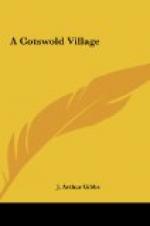The country, which has so far been rather hilly, now opens out into a flat tableland. You fly on, thankful that you are on a thoroughbred, and that he is in good condition. It pays well to keep a horse “up” all the summer in this country, for some of the quickest things of the season take place in October. Scent is often good at this time of the year, because the fields are full of keep: there is plenty of rough grass about. Later on they will be pared down by sheep, and the frost will make them as bare as a turnpike road. Then again that abomination, a “carrying” plough, is not so likely to be met with in October; the white frosts are not severe enough. Later on they are a constant source of annoyance to a huntsman, and invariably cause a check.
But your horse, well bred and fit though he be, is doing all he can to live with the hounds. Fortunately, you know that he is too good to chance a wall, even when blown. At the pace hounds are going you have not much time to trot slowly at the walls in the orthodox fashion; you must take them as they come, high and low alike, at a fair pace, taking a pull a few strides before your mount takes off. Oh, how exhilarating is a gallop in this fine Cotswold air in the cool autumnal morning! and what a splendid view you get of hounds! Here are no tall fences to hide them from your sight and to tempt a fox to run the hedgerows, no boggy woodlands where your horse flounders up to his girths in yellow clay, no ridge and furrow, and no deep ploughed fields.
What is the charm which belongs so exclusively to a fast and straight “run” over this wild, uncultivated region? It does not lie in the successful negotiation of Leicestershire “oxers,” Aylesbury “doubles,” or Warwickshire “stake-and-bound” fences, for there need be no obstacle greater than an occasional four-foot stone wall. Perhaps it lies partly in the fact that in a run over a level stone-wall country, where the enclosures are large and the turf sound, given a good fox and a “burning scent,” hounds and horses travel at as great a pace as they attain in any country in England. Here, moreover, if anywhere, is to be found the “greatest happiness for the greatest number,” the maximum of sport with the minimum of danger; the fine, free air of the high-lying Cotswold plains; the good fellowship engendered when all can ride abreast; the very muteness of the flying pack; the onslaught of a light brigade, or of “a flying squadron under the Admiral of the Red” sailing away over a sea of grass towards a region almost untrodden by man; the long sweeping stride of a well-bred horse; the unceasing twang of the horn to encourage flagging hounds beaten off by the pace and those which got left behind at the start; lastly, the glorious uncertainty! Can it last? Where will it all end? Shall we run “bang into him” in the open, or will he beat us in yonder cold scenting woodland standing boldly forth on the skyline miles ahead? All these things add a peculiar fascination to a fast run over this wild country.




